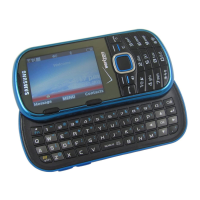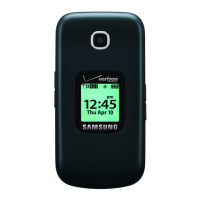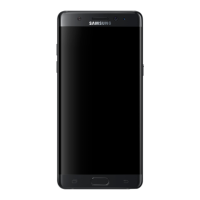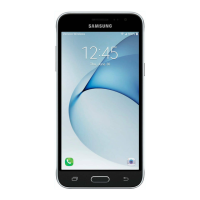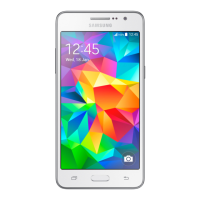Do you have a question about the Samsung Verizon SCH-U485 and is the answer not in the manual?
Explains how to use the manual and provides important safety information.
Details about the removable cover protecting the battery on the phone's back.
Step-by-step guide for installing the battery into the phone.
Step-by-step guide for removing the battery from the phone.
Instructions on how to charge the phone's battery using the included USB cable.
Warning about using unauthorized batteries and their potential damage.
How to power the phone on and off using the End/Power Key.
Guides setting preferences for font style, volume control, call sounds, and display themes.
Quickly set common settings for Sound and Display.
Explains preventing unauthorized access by locking the phone with a code.
How to lock and unlock the phone's external keypad automatically or manually.
Steps to set up voicemail and record a personal greeting.
How to listen to messages and manage voicemail.
Guide for inserting a microSD card into the phone.
Steps to remove a microSD card from the phone.
Process to erase card content and prepare it for phone use.
Overview of key phone features like data, keyboard, display, and tools.
Identification and description of the phone's front view components and keys.
Identification and description of the phone's side view components and keys.
Identification and description of the phone's open view components and keys.
Identification and description of the phone's back view components.
How to use directional keys to navigate menus and launch applications.
How to use directional keys to navigate menus and launch applications.
Explains the functions of the End/Power Key.
Usage of the Camera Key for camera functions.
Controls the Vibrate Only mode for sound alerts.
Describes the Annunciator and Event Status icons on the Home screen.
Explains icons in the top line showing phone status like signal and battery.
Options for customizing menu appearance and layout.
Lists and describes default items found on the phone's menu.
Explains various methods for making phone calls.
Describes different ways to answer incoming calls.
Methods to ignore an incoming call and send it directly to voicemail.
How to initiate calls directly from the Recent Calls log.
Steps to erase individual or all call records.
How to enable and manage Sound Alert Mode using voice commands.
Methods to access the Contacts List for managing contacts.
Step-by-step guide to add new contacts using the QWERTY keyboard.
Instructions for adding contacts using the external phone keypad.
How to save a number from a recent call record as a contact.
Steps to erase one or multiple contacts.
How to edit existing contacts using the external keypad.
How to edit a contact's group field to change assignment.
Steps to assign a speed dial number to a contact.
How to assign contacts or groups as favorites.
Steps to remove single or all favorites.
Assigning emergency contacts and entering personal information for emergencies.
Entering informational notes for emergency responders.
Steps to create your personal name card.
Sending contact information via Bluetooth to compatible devices.
How to access the phone's QWERTY keyboard for text input.
Selecting text entry modes like Abc, ABC, abc, XT9, or Symbols.
Using XT9 as a predictive text entry mode.
Inserting pre-loaded or custom phrases into messages.
Entering smiley symbols into text fields.
Lists supported message types: Text, Multimedia, Voicemail, Mobile Email.
How to compose and send simple text messages (SMS).
How to send messages with attached pictures, video, or sound (MMS).
Options for viewing or dismissing incoming messages.
How to set up the phone to access Facebook and Twitter for sharing.
How to easily update your status on Facebook or Twitter.
How to access the Twitter site for updates.
Features for managing songs, tones, and sounds.
Browsing the Media Center catalog for new ringtones.
Downloading and managing ringtones for alerts.
Launching the Music Player to play music files.
How to record and save new sounds for alerts.
Viewing and managing pictures stored on the phone or memory card.
Viewing and managing videos stored on the phone or memory card.
Launching the built-in camera to take pictures.
Recording videos using the phone's built-in camera.
Accessing the Online Album to view and manage pictures and videos.
Using the phone's built-in browser to access the mobile web.
Browsing the Media Center catalog for applications to load on the phone.
Playing music files transferred from a PC or memory card.
Steps to create a new music playlist.
How to add songs to an existing playlist.
Managing music files, including erasing, locking, and moving.
Capturing photos using the phone's built-in camera.
Configuring camera settings like mode, resolution, and effects.
Adjusting photo quality, review options, shutter sound, and memory location.
Viewing and managing pre-loaded, downloaded, or captured pictures.
Viewing, editing, and managing pictures.
Recording videos using the phone's built-in camera.
Configuring video recording settings like mode and quality.
Adjusting video quality, review options, and audio recording.
Viewing and managing videos stored on the phone or memory card.
How to view video thumbnails and play videos.
Accessing the Online Album to view and manage pictures and videos.
Operating the phone using spoken commands for various features.
Configuring voice command settings like readout and sensitivity.
Performing calculations using Normal, Tip, Eco, and Converter modes.
Converting values between different units.
Scheduling appointments, viewing the calendar, and setting alarms.
Setting up to three alarms that can go off once or recur periodically.
Steps to delete individual alarms or all alarms.
Measuring lap times and total elapsed time.
Viewing local and global city times.
Creating, storing, and editing text notes.
Editing, erasing, locking, or unlocking notes.
Searching for items on the phone by entering keywords.
Using GPS for location-based applications and directions.
Connecting to the Verizon Wireless Mobile Web.
Setting the master volume level for all phone sounds.
Specifications for services supported by individual Bluetooth devices.
How to turn Bluetooth on or off to save battery or comply with regulations.
Searching for and pairing with Bluetooth devices.
Controls whether the keypad locks automatically when the phone is closed.
Quickly setting basic sound preferences.
Choosing sounds for message alerts, emergency tones, and missed calls.
Choosing a tone for keypad presses.
Setting the volume for keypad press tones.
Enabling or disabling sounds for system or service status notifications.
Creating a personal greeting or network status banner for the Home screen.
Setting the duration and brightness of the display and keypad backlight.
Selecting a background image for the Lock Screen and Home screen.
Setting background images for the lock screen.
Customizing the appearance of menus and screens with themes.
Customizing features and applications available on the Main Menu.
Changing the location of menu items on the display.
Setting the style and size of fonts in the dialer and menus.
Selecting the format for the clock displayed on the Home screen.
Disabling wireless functions while keeping other features available.
Accessing favorite features via directional keys.
Choosing how the phone reacts when opening the QWERTY keyboard.
Managing GPS location availability for emergency calls or general use.
Setting the country code for proper phone operation during travel.
Setting restrictions for receiving calls and messages.
Setting the locking behavior of the phone for security.
Selecting how to answer incoming calls (Slide Open, Any Key, Auto with Handsfree).
Enabling TTY compatibility for connecting to TTY devices.
Enabling or disabling voice signal encryption for enhanced privacy.
Setting DTMF tone length for automated phone systems.
Using the feature to simulate a fake incoming call.
Choosing the default location for pictures and sounds.
Browsing and viewing content stored on the phone's internal memory.
Browsing and viewing content stored on an optional installed memory card.
Information on RF exposure from wireless phones as published by the FDA.
Study on long-term health monitoring related to RF energy exposure.
Steps to minimize RF exposure using hands-free kits and accessories.
Information on FCC RF exposure limits and SAR measurements.
Compliance information for Class B digital devices and interference.
Receiving Wireless Emergency Alerts from CMAS.
Guidelines for safe driving and minimizing distractions from mobile devices.
Steps to initiate an emergency call on the mobile device.
Details what is covered by the warranty and for how long.
Outlines the extent of Samsung's responsibilities and limitations on liability.
Explains the process for resolving disputes through arbitration.
Clause regarding the enforceability of warranty provisions.
Recommendations for data transfer and disposal of the device.
Explains how to use the manual and provides important safety information.
Details about the removable cover protecting the battery on the phone's back.
Step-by-step guide for installing the battery into the phone.
Step-by-step guide for removing the battery from the phone.
Instructions on how to charge the phone's battery using the included USB cable.
Warning about using unauthorized batteries and their potential damage.
How to power the phone on and off using the End/Power Key.
Guides setting preferences for font style, volume control, call sounds, and display themes.
Quickly set common settings for Sound and Display.
Explains preventing unauthorized access by locking the phone with a code.
How to lock and unlock the phone's external keypad automatically or manually.
Steps to set up voicemail and record a personal greeting.
How to listen to messages and manage voicemail.
Guide for inserting a microSD card into the phone.
Steps to remove a microSD card from the phone.
Process to erase card content and prepare it for phone use.
Overview of key phone features like data, keyboard, display, and tools.
Identification and description of the phone's front view components and keys.
Identification and description of the phone's side view components and keys.
Identification and description of the phone's open view components and keys.
Identification and description of the phone's back view components.
How to use directional keys to navigate menus and launch applications.
How to use directional keys to navigate menus and launch applications.
Explains the functions of the End/Power Key.
Usage of the Camera Key for camera functions.
Controls the Vibrate Only mode for sound alerts.
Describes the Annunciator and Event Status icons on the Home screen.
Explains icons in the top line showing phone status like signal and battery.
Options for customizing menu appearance and layout.
Lists and describes default items found on the phone's menu.
Explains various methods for making phone calls.
Describes different ways to answer incoming calls.
Methods to ignore an incoming call and send it directly to voicemail.
How to initiate calls directly from the Recent Calls log.
Steps to erase individual or all call records.
How to enable and manage Sound Alert Mode using voice commands.
Methods to access the Contacts List for managing contacts.
Step-by-step guide to add new contacts using the QWERTY keyboard.
Instructions for adding contacts using the external phone keypad.
How to save a number from a recent call record as a contact.
Steps to erase one or multiple contacts.
How to edit existing contacts using the external keypad.
How to edit a contact's group field to change assignment.
Steps to assign a speed dial number to a contact.
How to assign contacts or groups as favorites.
Steps to remove single or all favorites.
Assigning emergency contacts and entering personal information for emergencies.
Entering informational notes for emergency responders.
Steps to create your personal name card.
Sending contact information via Bluetooth to compatible devices.
How to access the phone's QWERTY keyboard for text input.
Selecting text entry modes like Abc, ABC, abc, XT9, or Symbols.
Using XT9 as a predictive text entry mode.
Inserting pre-loaded or custom phrases into messages.
Entering smiley symbols into text fields.
Lists supported message types: Text, Multimedia, Voicemail, Mobile Email.
How to compose and send simple text messages (SMS).
How to send messages with attached pictures, video, or sound (MMS).
Options for viewing or dismissing incoming messages.
How to set up the phone to access Facebook and Twitter for sharing.
How to easily update your status on Facebook or Twitter.
How to access the Twitter site for updates.
Features for managing songs, tones, and sounds.
Browsing the Media Center catalog for new ringtones.
Downloading and managing ringtones for alerts.
Launching the Music Player to play music files.
How to record and save new sounds for alerts.
Viewing and managing pictures stored on the phone or memory card.
Viewing and managing videos stored on the phone or memory card.
Launching the built-in camera to take pictures.
Recording videos using the phone's built-in camera.
Accessing the Online Album to view and manage pictures and videos.
Using the phone's built-in browser to access the mobile web.
Browsing the Media Center catalog for applications to load on the phone.
Playing music files transferred from a PC or memory card.
Steps to create a new music playlist.
How to add songs to an existing playlist.
Managing music files, including erasing, locking, and moving.
Capturing photos using the phone's built-in camera.
Configuring camera settings like mode, resolution, and effects.
Adjusting photo quality, review options, shutter sound, and memory location.
Viewing and managing pre-loaded, downloaded, or captured pictures.
Viewing, editing, and managing pictures.
Recording videos using the phone's built-in camera.
Configuring video recording settings like mode and quality.
Adjusting video quality, review options, and audio recording.
Viewing and managing videos stored on the phone or memory card.
How to view video thumbnails and play videos.
Accessing the Online Album to view and manage pictures and videos.
Operating the phone using spoken commands for various features.
Configuring voice command settings like readout and sensitivity.
Performing calculations using Normal, Tip, Eco, and Converter modes.
Converting values between different units.
Scheduling appointments, viewing the calendar, and setting alarms.
Setting up to three alarms that can go off once or recur periodically.
Steps to delete individual alarms or all alarms.
Measuring lap times and total elapsed time.
Viewing local and global city times.
Creating, storing, and editing text notes.
Editing, erasing, locking, or unlocking notes.
Searching for items on the phone by entering keywords.
Using GPS for location-based applications and directions.
Connecting to the Verizon Wireless Mobile Web.
Setting the master volume level for all phone sounds.
Specifications for services supported by individual Bluetooth devices.
How to turn Bluetooth on or off to save battery or comply with regulations.
Searching for and pairing with Bluetooth devices.
Controls whether the keypad locks automatically when the phone is closed.
Quickly setting basic sound preferences.
Choosing sounds for message alerts, emergency tones, and missed calls.
Choosing a tone for keypad presses.
Setting the volume for keypad press tones.
Enabling or disabling sounds for system or service status notifications.
Creating a personal greeting or network status banner for the Home screen.
Setting the duration and brightness of the display and keypad backlight.
Selecting a background image for the Lock Screen and Home screen.
Setting background images for the lock screen.
Customizing the appearance of menus and screens with themes.
Customizing features and applications available on the Main Menu.
Changing the location of menu items on the display.
Setting the style and size of fonts in the dialer and menus.
Selecting the format for the clock displayed on the Home screen.
Disabling wireless functions while keeping other features available.
Accessing favorite features via directional keys.
Choosing how the phone reacts when opening the QWERTY keyboard.
Managing GPS location availability for emergency calls or general use.
Setting the country code for proper phone operation during travel.
Setting restrictions for receiving calls and messages.
Setting the locking behavior of the phone for security.
Selecting how to answer incoming calls (Slide Open, Any Key, Auto with Handsfree).
Enabling TTY compatibility for connecting to TTY devices.
Enabling or disabling voice signal encryption for enhanced privacy.
Setting DTMF tone length for automated phone systems.
Using the feature to simulate a fake incoming call.
Choosing the default location for pictures and sounds.
Browsing and viewing content stored on the phone's internal memory.
Browsing and viewing content stored on an optional installed memory card.
Information on RF exposure from wireless phones as published by the FDA.
Study on long-term health monitoring related to RF energy exposure.
Steps to minimize RF exposure using hands-free kits and accessories.
Information on FCC RF exposure limits and SAR measurements.
Compliance information for Class B digital devices and interference.
Receiving Wireless Emergency Alerts from CMAS.
Guidelines for safe driving and minimizing distractions from mobile devices.
Steps to initiate an emergency call on the mobile device.
Details what is covered by the warranty and for how long.
Outlines the extent of Samsung's responsibilities and limitations on liability.
Explains the process for resolving disputes through arbitration.
Clause regarding the enforceability of warranty provisions.
Recommendations for data transfer and disposal of the device.
| Network Technology | CDMA / EVDO |
|---|---|
| 2G bands | CDMA 800 / 1900 |
| GPRS | No |
| EDGE | No |
| Status | Discontinued |
| Type | TFT, 256K colors |
| Call records | Yes |
| Camera | 1.3 MP |
| Loudspeaker | Yes |
| 3.5mm jack | No |
| Browser | WAP 2.0/xHTML |
| Games | Yes |
| Java | Yes, MIDP 2.0 |
| Battery | Removable Li-Ion 1000 mAh battery |
| Model | SCH-U485 |
| Size | 2.2 inches, 15.2 cm2 |
| Resolution | 240 x 320 pixels |
| Memory Card slot | microSD |
| Alert types | Vibration, MP3 ringtones |
| USB | Yes, 2.0 |
| Messaging | SMS, MMS, Email |
| Colors | Black |
| Expandable Memory | microSD |
